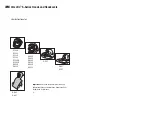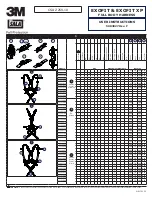
3. Control elements
The GF equalizer is a true two-channel equalizer with totally
independent circuits. All functional elements are implemented
twice which allows individual equalization of both channels. As
both channels feature exactly the same controls, the following
descriptions refer to only one channel.
EQ in
To activate the EQ function, the 'EQ in' switch must be enga-
ged, which is indicated by its control LED. When the 'EQ in'
switch is not pushed, the unit is in bypass mode (dark LED) and
all control elements on the front panel become inactive. In
bypass mode, the inputs and outputs become directly wired
together by a low-active relay, which also serves as a failsafe
protection device, so that the signal path is not interrupted even
if the unit should become defective or the mains power has
been turned off.
Gain control and 'Headroom' LED meter
The audio signal coming into the GF equalizer is initially going
through a preamplifier stage, where it can be amplified or
attenuated by means of the 'Gain' control knob. This control
affects only the equalized signal and has no effect when the
'EQ in' pushbutton is not activated. With all EQ faders set to
their neutral position and the 'Gain' control at center detent
position, the signal is not amplified or attenuated by the unit
and has the same level in 'EQ on' and bypass mode.
Alterations of the signal level inside the equalizer can be con-
trolled by means of the 'Headroom' LED meter. This 5-step
LED display is not only a simple input level meter, but also
senses the signal levels inside the filter stages. Whenever a
signal level exceeds its maximum value somewhere inside the
electronic circuit, the 'Clip' LED will become lit. The numbers on
the right of the LEDs indicate the gain reserve in dB before clip-
ping will occur.
Faders
Each of the faders is labelled with its assigned center frequen-
cy. By changing the fader settings, however, not only the speci-
fied center frequency is affected, but also a certain frequency
range below and above this center frequency, called 'band-
width'. This bandwidth, which is the same for all faders, has
been calculated for the correct overlap between two neighbou-
ring faders to avoid 'holes' or 'humps' in the frequency spec-
trum. Each fader has a cut/boost range of -12dB to +12dB in
relation to its center position. Even without any knowledge in
decibel arithmetic, one can easily remember that a gain increa-
se of 6 dB means doubling the voltage, whereas as gain
decrease of 6 dB means decreasing it by half. As an example
of this calculation, a single sinewave frequency of 1kHz and
1Volt can be adjusted anywhere between 0.25 Volts and 4
Volts by means of the 1kHz fader, with 0dB meaning no amplifi-
cation. The center frequencies were selected following the ISO
standard, where the distance between two center frequencies
is 2/3 of an octave on the GF215 and 1/3 of an octave on the
GF230. The following chart specifies the center frequencies,
their corresponding musical notes and frequency domains:
GF 215
GF 230
Note
25 Hz
25 Hz
G2
31 Hz
H2
40 Hz
40 Hz
D#1
bass
50 Hz
G1
63 Hz
63 Hz
H1
80 Hz
D#
100 Hz 100 Hz
G
GF 215
GF 230
Note
125 Hz
H
160 Hz 160 Hz
d#
200Hz
g
low mid
250 Hz 250 Hz
h
315 Hz
d#1
400 Hz 400 Hz
g1
500 Hz
h1
630 Hz 630 Hz
d#2
mid
800 Hz
g2
1 kHz
1 kHz
h2
1.25 kHz
d#3
1.6 kH
1.6 kHz
g3
2 kHz
h3
2.5 kHz
2.5 kHz
d#4
presence
3.15 kHz
g4
4 kHz 4 kHz
h4
5 kHz
d#5
6.3 kHz 6.3 kHz
g5
8 kHz
h5
10 kHz 10 kHz
d#6
treble
12.5 kHz
g6
16 kHz
16 kHz
h6
20 kHz
d#7
Low cut
The 'Low cut' switch activates an internal highpass filter, which
attenuates all frequencies below 40 Hz with a cutoff slope of 18
dB/octave. This can be useful to keep unwanted ultra-low sub-
sonic frequencies out of a sound reinforcement system.
4. Using the GF Equalizer
What is a graphic equalizer ?
The name equalizer, or just 'EQ' in short, has its origin in the
idea that a sound system should be able to deliver a linear fre-
quency response, so that all frequencies are perceived by the
listeners with the same loudness. For many reasons, however,
sound systems alone are often not able to satisfy this require-
ment because of their non-linear frequency response, hence
the need to be able to boost or cut the gain of individual fre-
quencies toward an even response. A graphic equalizer provi-
des just that by dividing the incoming audio signal into several
frequency bands (15 bands for the GF 215 and 30 bands for
the GF 230), which can be attenuated or boosted individually.
On a graphic equalizer, these adjustments are done by slide
potentiometers (faders) mounted side by side, giving a perfect
'graphic' visualization of the adjusted equalization curve. But
leveling out frequency responses is not all that an equalizer can
do. It can also be used to fine-tune the sounds of musical
instruments to meet different musical requirements, or even for
noise suppression. More examples of highly useful applications
for the GF equalizers will be given below.
Adjusting gain
Since the fader settings, just as the 'Gain' control, affect the
'headroom' LED display, gain adjustments should be done after
the final equalizer setting has been found (see below). If you
are using the GF equalizer following a mixing console, start off
by setting the mixer's volume faders to their maximum, apply all
channel signals and check the 'Headroom' display. If clipping
occurs, turn the 'Gain' control counterclockwise to compensate
for about 3 to 6dB available headroom. If the display still indica-
tes clipping, the signal level coming into the equalizer is too
high and must be reduced. After the sound system has been
tuned for the desired frequency response, check the 'Head-
room' display again and compensate again with the 'Gain' con-
trol knob. As a guideline, try to set the gain as high as possible
owner's manual GF equalizers
15
owner`s manual GF equalizers © 1994 Zeck Audio






































